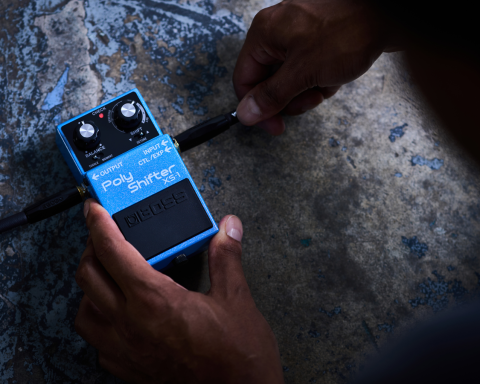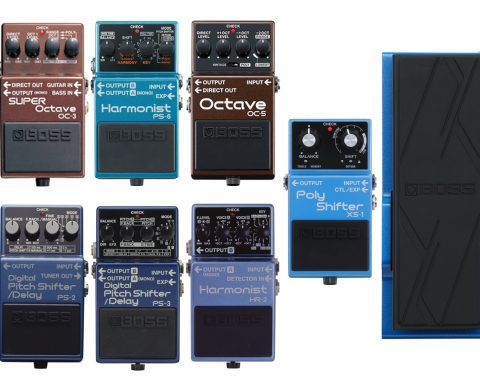Modulation effects can be a unique and creative way to excite a guitar tone. Where overdrives, compressors, and octave pedals perform a functional role, guitarists can apply modulation freely and creatively. None more so than the original modulation pedal itself, the humble chorus effect. Here are some unique and creative ways to use the effect to enhance a guitar tone.
The History of Chorus
If fuzz effects defined the sound of the ’60s, then chorus was the definitive sound of the ’80s. But don’t mistake it for a limited tone; chorus is an effect that transcends genres. Used carefully, it can find application in more or less any type of music. From Prince to Metallica, The Cure to Nirvana, chorus is a unique effect at the forefront of modern music since 1975.
The history of chorus and the evolution of the effect throughout decades of popular music is fundamentally linked to Roland and BOSS. Roland first introduced chorus for guitarists in 1975 as a built-in feature of the Roland Jazz Chorus amplifier.
"From Prince to Metallica, The Cure to Nirvana, chorus is a unique effect at the forefront of modern music since 1975."

Less than a year later, in June of 1976, BOSS announced its first-ever effects pedal, the CE-1 Chorus Ensemble, a unit initially for keyboard players. Yet, guitarists at the time took a shine to this pedal. In 1979, BOSS announced the new and improved CE-2 Chorus in a modern BOSS stompbox chassis. Inspired by the original CE-1, BOSS designed it with a pronounced midrange and simplified layout for guitarists.
The original BOSS chorus effects were a defining element of music throughout the ’80s. BOSS developed many different types of chorus effects, releasing more variants than almost any other pedal in its catalog.
How Chorus Works
The original concept of chorus was to emulate the effect of two instruments playing the same thing simultaneously. Because no two musicians will have the same pitch or timing, this creates a subtle choir-like effect, enhancing the width and impact of the music.
Chorus achieves this emulation by creating two audio signals. One is the original audio getting passed through the effect primarily unaltered. The other is slightly detuned and delayed. This emulates the subtle difference in pitch between the two instruments and the slight variance in timing.
"The original concept of chorus was to emulate the effect of two instruments playing the same thing simultaneously."
Players can alter a signal’s detuning and delay in depth and speed on most chorus pedals. In addition, the balance between the affected and clean signals is adjustable. At its most extreme, a chorus effect can sound like a vibrato or tremolo. On the other hand, at its subtlest, chorus provides a mild thickening, much like a tight slapback delay.
Setup Considerations
Most modulation pedals are at their best positioned relatively late in an effects chain. Place compressors, overdrives, distortions, and octave effects ahead of modulation pedals. Delays and reverb effects should come afterward.
Chorus pedals are excellent partners to overdrives. They can enhance and thicken a drive tone. However, they work best when positioned to receive the drive signal. By contrast, delays and reverbs sound best after, so the delay tails remain clean and unaltered.
FIVE CHORUS PEDAL USES
1. Delicate Chorus to Thicken a Solo
Chorus is an effect that thrives when used with care. It’s important to notice what a great job it can do to enhance a guitar tone delicately. Michel Angelo Batio is an excellent example of a guitarist who subtly uses chorus for his lead tone. It strengthens his playing, adding depth without overpowering his screaming, overdriven guitar tone.
To create a subtle chorus for lead guitar parts, set the rate control at around 12 o’clock and the depth control at 10 o’clock. The result will gently thicken the tone without overpowering the basic sound.
"Chorus is an effect that also sounds great when used aggressively, so don't be afraid to push the pedal a little further."
2. Heavy Chorus
Chorus is an effect that also sounds great when used aggressively, so don’t be afraid to push the pedal a little further. The swirling, detuned wash of a chorus isn’t just for replicating your favorite ’80s tunes. “Come As You Are” by Nirvana is a beautiful example of a chorus pedal with a relatively high depth and rate setting. In that alternative rock classic, the treble-heavy bite of Cobain’s guitar pairs perfectly with the thick sound for a memorable tone.
3. Wild Spacey Chorus
A chorus pedal can sound almost entirely out of tune when pushed to its most extreme settings. The warble of the detuned notes produces a vibrato-like effect. While this might seem like a setting to avoid, it can be a secret weapon. Ideal for unique riffs, it’s perfect for the player unafraid of the wilder corners of music. John Scofield’s “Just My Luck” is an excellent example of chorus pushed to its absolute limits. And while it can sound slightly out of tune, it can be a valuable tool in one’s sonic arsenal when carefully applied.
"The warble of a chorus creating detuned notes can produce a vibrato-like effect. While this might seem like a setting to avoid, it can be a secret weapon."
4. Dreamy Chorus
Chorus effectively creates a dreamy, otherworldly tone, perfect for enhancing a picked guitar part. This vibe can work exceptionally well with an acoustic guitar. John Petrucci’s intro to Dream Theater’s “Pull Me Under” is a strong example of a wide chorus effect enhancing a simple progression.
Try using a chorus with a clean electric or an acoustic-electric guitar to unlock an ethereal character on straightforward, picked progressions. When applied to clean guitar tones, use chorus gently, with the rate and depth controls at no more than 12 o’clock. The effect’s impact will remain considerable, while the detuning characteristic won’t be overpowering.
5. Chorus for Bass
When discussing chorus, we have to touch on how well-suited the effect is for bass, particularly fretless. Chorus on fretless bass played a massive role in ’80s pop. From Genesis to Jaco Pastorius, the pairing has such a unique and luscious character that it’s worth exploring.
When used with bass guitar, chorus effects add depth to a simple, fundamental bassline. For bassists playing with one guitarist, chorus can fatten sections where the guitarist plays melody or lead. In these moments, the effect can mask the lack of a rhythm. Of course, it also sounds great on its own. Jaco Pastorius’ “Continuum” is a stunning example of how well the instrument and the effect sound when used together.
"When used with bass guitar, chorus effects add depth to a simple, fundamental bassline."
Era-Defining Modulation
Chorus is a wonderful tool to reinvigorate a clean guitar sound or enhance a drive tone. It can be a subtle thickener or a crazy spacey vibrato. In fact, chorus may be the modulation pedal that defined the ’80s. And while it’s undoubtedly a fantastic tool for retro tones, it can be so much more than that. Chorus is a go-to modulation effect as essential to a guitarist’s setup as overdrive or delay.







